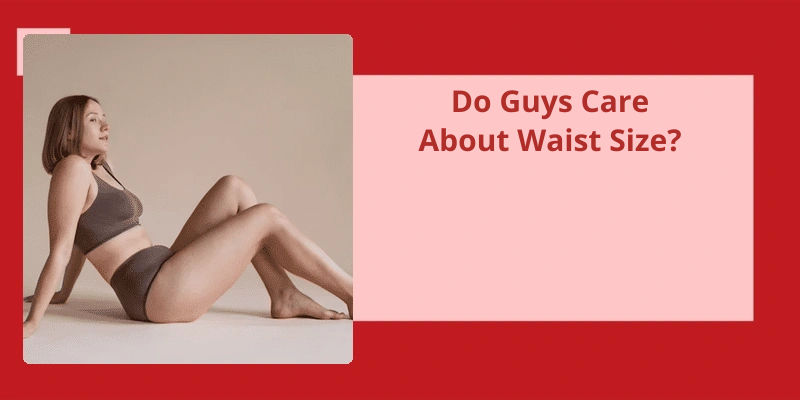They’ve been linked to fertility and childbirth, making them a subconscious signal of a woman's reproductive potential. However, the focus on waist size goes beyond evolutionary biology. Society and media have played a significant role in shaping the perception of attractiveness, often favoring an hourglass figure. This has created a cultural standard that exalts a slim waist as a symbol of beauty and femininity. Ultimately, the beauty of individual preferences lies in the eye of the beholder, and what matters most is finding someone who appreciates and loves you for who you are, irrespective of your waist size.
What Is the Most Attractive Waist Size?
The question of the most attractive waist size is subjective and can vary depending on individual preferences. However, numerous studies suggest that the ideal waist size for women is generally considered to be less than 35 inches. This ideal waist size is often associated with an hourglass figure, which is traditionally seen as highly desirable in many cultures.
This measurement is often seen as an indicator of overall health and fitness. A smaller waist size in men is associated with a lower risk of obesity-related health issues, such as heart disease and diabetes.
It’s important to note that these numbers are general guidelines and shouldn’t be interpreted as absolute standards for attractiveness. Personal preferences can vary greatly, and what one person finds attractive may differ from another. Additionally, it’s crucial to remember that beauty standards are culturally influenced and can change over time.
Ultimately, attraction is a complex and multi-faceted concept that encompasses much more than just waist size. Physical appearance is just one component of overall attractiveness, which also includes personality, intelligence, confidence, and many other factors. It’s essential to recognize and appreciate the diversity of body shapes and sizes that exist, and to focus on overall health and well-being rather than conforming to rigid societal standards.
The Role of Waist-to-Hip Ratio in Attractiveness
- Waist-to-hip ratio is a measure of body proportions that’s believed to influence attractiveness.
- It’s calculated by dividing the circumference of the waist by the circumference of the hips.
- A low waist-to-hip ratio, indicating a relatively smaller waist compared to the hips, is often associated with higher attractiveness.
- Research has suggested that a waist-to-hip ratio of around 0.7 is considered most appealing in females.
- This ideal ratio may signal reproductive health and fertility, as well as youth and vitality.
- However, it’s important to note that beauty standards and preferences can vary across cultures and individuals.
- While waist-to-hip ratio is one factor that may influence perceived attractiveness, it isn’t the sole determinant.
- Other physical features, personality traits, and personal preferences also play significant roles.
- Ultimately, attractiveness is subjective and can vary greatly from person to person.
They’re often drawn to women with an hourglass figure, characterized by a smaller waist in relation to wider hips. However, recent research suggests that an individual’s body size preferences can vary, reflecting personal preferences and cultural influences.
What Body Size Are Men Most Attracted To?
When it comes to attractiveness, men often have a preference for a certain body size in women. Studies have shown that men are generally most attracted to women with a waist-to-hip ratio of 0.This means that for every 70cm waist measurement, they prefer a hip measurement of around 100cm. However, it’s important to note that this preference isn’t solely based on the specific numbers, but rather on the overall proportions.
In fact, research suggests that men are more drawn to the curviness and hourglass shape that a 0.7 waist-to-hip ratio represents. This preference for curves can be traced back to evolutionary psychology, as these proportions are associated with fertility and childbearing potential. From an evolutionary perspective, men may be wired to be attracted to women who’ve the physical characteristics that indicate a higher likelihood of reproductive success.
Despite this preference for curviness, it’s crucial to remember that attraction is subjective and can vary from person to person. Not all men will find the same body shape appealing. Furthermore, societal standards of beauty and media influences can also play a role in shaping individual preferences.
Ultimately, it’s important for individuals to embrace and love their own bodies, regardless of societal expectations or specific attraction preferences. Confidence and self-acceptance are often the most attractive qualities one can possess. Attraction is a complex interplay of various factors, and focusing on one specific body size or feature can limit our understanding and appreciation of the diverse beauty that exists.
When it comes to determining what’s considered a small waist for a woman, it’s important to keep in mind that it varies depending on factors such as body type and height. While a 27-inch waist is considered small in comparison to the average female’s, it’s essential to focus on overall health and fitness rather than solely on achieving a specific waist size.
What Is Considered a Small Waist for a Woman?
When it comes to determining what’s considered a small waist for a woman, one common measurement that’s often used as a reference is a 27-inch waist. This is because a 27-inch waist is approximately 9 inches smaller than the average females waist size. In comparison to the general population, a 27-inch waist can be seen as petite and slender.
What may be considered small for one woman might not be the same for another. Our bodies are unique, and what’s deemed attractive or healthy can vary greatly from person to person.
It isn’t uncommon for women who prioritize their fitness to have waist measurements smaller than the average population. Nevertheless, it’s crucial to remember that the pursuit of health and fitness shouldn’t be solely centered around achieving a specific waist size, but rather on overall well-being.
Health Implications of Having a Small Waist
A small waist can have various health implications. One major benefit is a reduced risk of chronic diseases such as heart disease, diabetes, and high blood pressure. This is because excess abdominal fat, which is typically associated with a larger waist size, is linked to these health conditions.
Having a smaller waist also indicates a lower body mass index (BMI), which is often associated with a healthier weight. Maintaining a healthy weight can contribute to overall well-being, as it can help improve energy levels, enhance mobility, and reduce the strain on joints.
Furthermore, a small waist is often an indicator of a healthier body composition. Adequate muscle mass coupled with a smaller waist can contribute to better metabolism and body function. It may also be associated with improved physical performance and reduced risk of injuries.
While it’s important to note that waist size alone isn’t the only measure of health, maintaining a smaller waist can have positive implications for overall well-being. However, it’s always crucial to prioritize overall health and body positivity rather than focusing solely on appearance or specific body measurements.
Source: Is 27 Inches a Small Waist? See The Statistics | Nutritioneering
Maintaining a healthy waist size is an essential aspect of overall well-being, particularly for women. Experts suggest that a waist circumference should be less than half of a person’s height. For instance, a 5-foot-2 woman should aim for a waist size under 31 inches. By understanding these guidelines, individuals can work towards achieving and maintaining an ideal waist size for a healthier lifestyle.
What Is the Ideal Waist Size for a Woman?
When it comes to determining the ideal waist size for a woman, it’s important to consider various factors. One commonly used guideline is to keep waist circumference to less than half your height. This provides a rough estimate for a healthy waist size. For instance, for a 6-foot man measuring 72 inches, a healthy waist size would be anything less than 36 inches. Similarly, for a 5-foot-2 woman measuring 62 inches, a healthy waist size would be anything less than 31 inches.
Some women naturally have wider or narrower waistlines, and that doesn’t necessarily indicate poor health. Each persons body is unique, and what matters most is maintaining overall physical well-being rather than striving for a specific waist size.
Additionally, it’s essential to prioritize a healthy lifestyle over a specific waist measurement. Engaging in regular physical activity, eating a balanced diet, and practicing good self-care are important for maintaining overall health and well-being. These habits can positively impact body composition, including waist circumference.
It’s worth noting that societal standards and media portrayals often promote a slim and hourglass figure as the ideal for women. However, it’s crucial to remember that beauty and attractiveness are subjective, and everyone has different preferences. Generalizations about waist size may not reflect the diversity of preferences and opinions held by individuals. Ultimately, what truly matters is feeling confident and comfortable in your own body, regardless of societal standards or expectations.
The Correlation Between Waist Size and Overall Health
The correlation between waist size and overall health is an important topic to consider. While it isn’t the sole determinant of one’s health, studies have shown that excess fat around the waist, also known as central obesity, can increase the risk of several health issues such as heart disease, type 2 diabetes, and certain types of cancer.
Men, like women, should pay attention to their waist size as it can serve as a potential indicator of their health. A large waist circumference may suggest the presence of visceral fat, which surrounds vital organs and poses greater health risks compared to subcutaneous fat found elsewhere in the body.
However, it’s important to note that waist size alone isn’t a definitive measure of overall health. Other factors like body mass index (BMI), lifestyle choices, genetics, and overall body composition should also be taken into account. Maintaining a healthy weight through a balanced diet, regular exercise, and a healthy lifestyle can greatly contribute to overall physical well-being, regardless of waist size.
Furthermore, studies have also revealed that men tend to be particularly drawn to women with smaller waist sizes due to various subconscious factors, suggesting a deeper evolutionary and cultural significance behind this preference.
Why Do Guys Like Girls With Small Waists?
Do guys care about waist size when it comes to attraction? The answer seems to be yes, and science offers some insights into this phenomenon. Research conducted by Scottish scientists has shown that men are highly attracted to women with a smaller waist. It’s been found that the slimmer a womans waist, the more satisfied her partner tends to be and the less likely he’s to suffer from erectile dysfunction.
Why is this the case? One possible explanation is that a smaller waist is associated with an hourglass figure, which is considered highly attractive in many cultures. The hourglass shape is often seen as a symbol of fertility and good reproductive health. From an evolutionary standpoint, men may be instinctively drawn to women with small waists as they perceive them as having a higher likelihood of bearing healthy offspring.
Furthermore, a slim waist can also be seen as a sign of overall physical fitness and good health. It indicates that the person engages in regular exercise and maintains a balanced diet, which are attractive qualities in a potential partner.
It’s important to note that individual preferences can vary, and not all men have the same preferences when it comes to waist size. Beauty standards and attractiveness can differ across cultures and change over time. Additionally, it’s essential to remember that attraction is a complex and multifaceted phenomenon influenced by various factors, including personality traits, shared interests, and emotional connection.
This attraction may be related to evolutionary factors, as well as beauty ideals and perceptions of good health. However, it’s crucial to recognize that individual preferences and societal standards may vary, and attraction isn’t solely based on physical appearance. Building a meaningful and fulfilling relationship requires more than just physical attributes, and emotional connection and compatibility play equally important roles.
Conclusion
Scientific studies have revealed that men are naturally drawn to women with curvier figures, specifically highlighting the importance of a slim waist. It appears that a woman's waist size not only plays a role in physical attraction but also indicates her partner's satisfaction and even impacts his sexual health. Additionally, wide hips have been identified as a sexually dimorphic trait, further highlighting the natural preference for certain body proportions.





